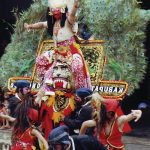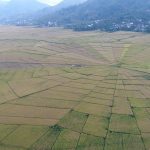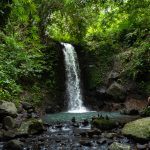Manggarai Culture

Little is recorded about the Manggarai culture of Flores, Indonesia. Even a simple search leads you to limited and repetitive information. For a culture that has been around for thousands of years, it is surprising that more is not known.
The limited information might stem from the fact that the Manggarai culture has a small population of only 725,000 people whom all live on Flores. Manggaraian are mostly found to be living in the west third of Flores. This is a mountain dominated culture. Although some villages do live near the sea.
The most well known Manggarai village is Wae Rebo. This village signifies the only remaining authentic character of Manggarain traditional houses. The 1,080 year old village is placed between two agriculture skewed mountains and holds 7 traditional houses. Each house is made from natural resources in the jungle that surrounds them. They can fit up to 8 families in each 8 meter high, cone shaped home. It was only recently that these homes were rebuilt as they were beginning to degrade. Wae Rebo is now a UNESCO site and a great place to visit and spend the night if you’re in the neighborhood.
If you’re not familiar with UNESCO, they are worth taking a moment to look into. Their mission is largely to help all countries with sustainable development.
Houses used to be much more than a shelter to the Manggarai. They were used as an expression of identity and belonging. Homes were able to symbolize kinship and marriage relations, as well as patrilineal descent. Entire clans used to inhabit a single house with generations living side by side. Eventually when the Dutch colonized the area, they deemed the living situations unsanitary and destroyed many homes across the island.
The Manggarai live in remote places and make do without modern conveniences. Their survival and main income comes from agriculture. The main staples are rice and corn for income and consuming. This is supplemented by coconuts, cinnamon, coffee, and tobacco. Because they are mountain people, they are not known to use much fish in their diet. Spider web rice fields are a practice they employ. These began long ago when they relied on dry rice farming. The center of the rice field was used for ceremonies and the land was doled out to families depending on their size. Now that wet rice is mostly farmed, spider web fields are not rampant, but still exist and are very beautiful.
The Manggarai have many festivals for many different occasions. Animal sacrifice, sword fighting (or Caci), blessings, music, and costumes are all used depending on the event. For special occasions they don their traditional ikats that they have made themselves and have a day of feasts and rituals. I have attended a couple of them already with more in my future. I really enjoy their intense sense of community and their welcoming spirits. These people are so excited and happy to share their lives with outsiders, making it impossible for westerners to think poorly of the sacrifices for even one second. Their beliefs and actions are so strongly instilled amongst them and beautifully practiced. I encourage you all to get down here and spend some time with these seemingly elusive and amazing people.
If you’re interested in reading up on the culture of Indonesia, here are a couple of books that I recently finished that have fueled my desire for adventure and meeting new people in this immense country. They are great sources of information and you won’t find yourself bored, I promise.
- Ring of Fire by Lawerence Blair
- Indonesia Etc. by Elizabeth Pisani




